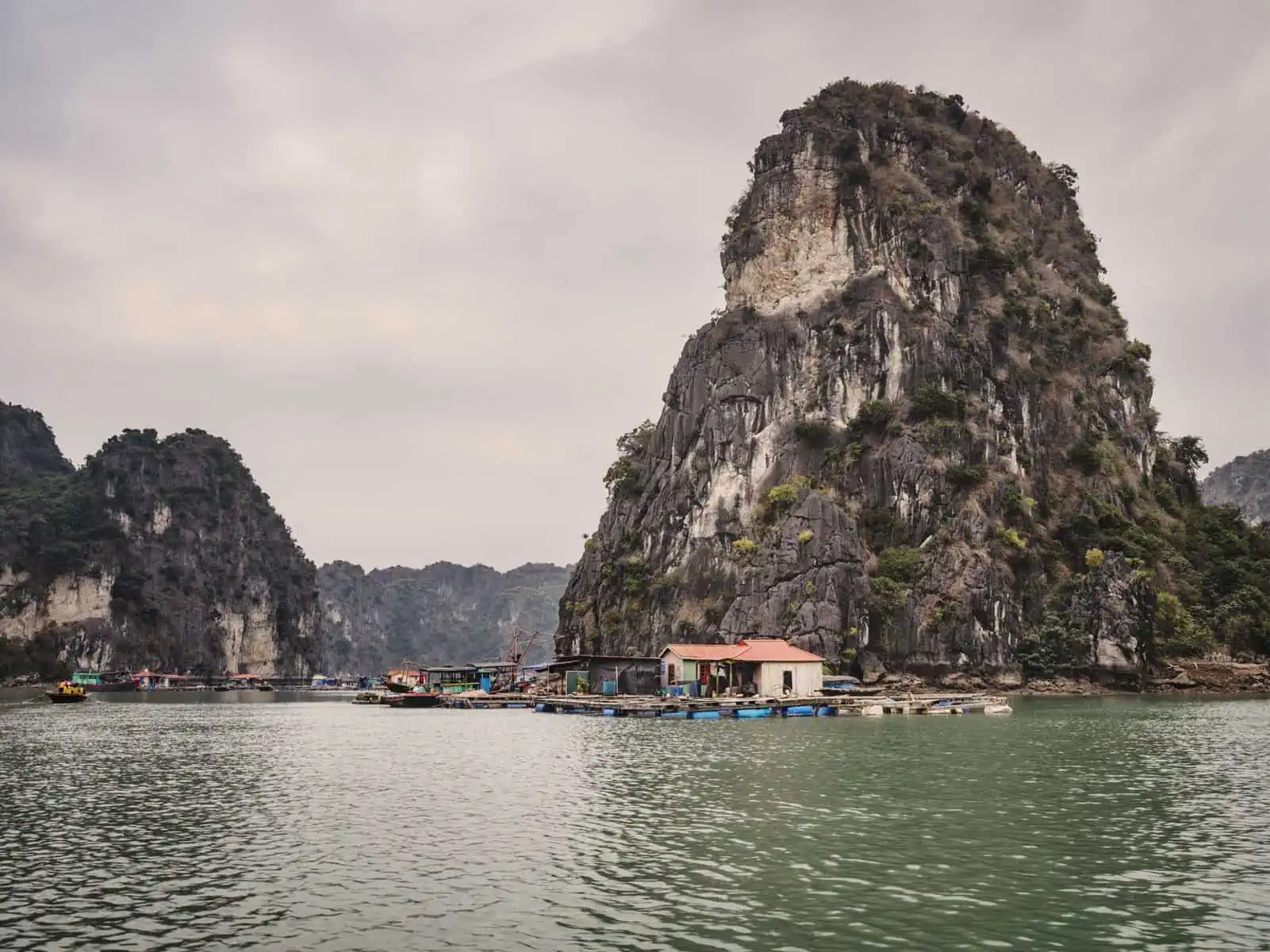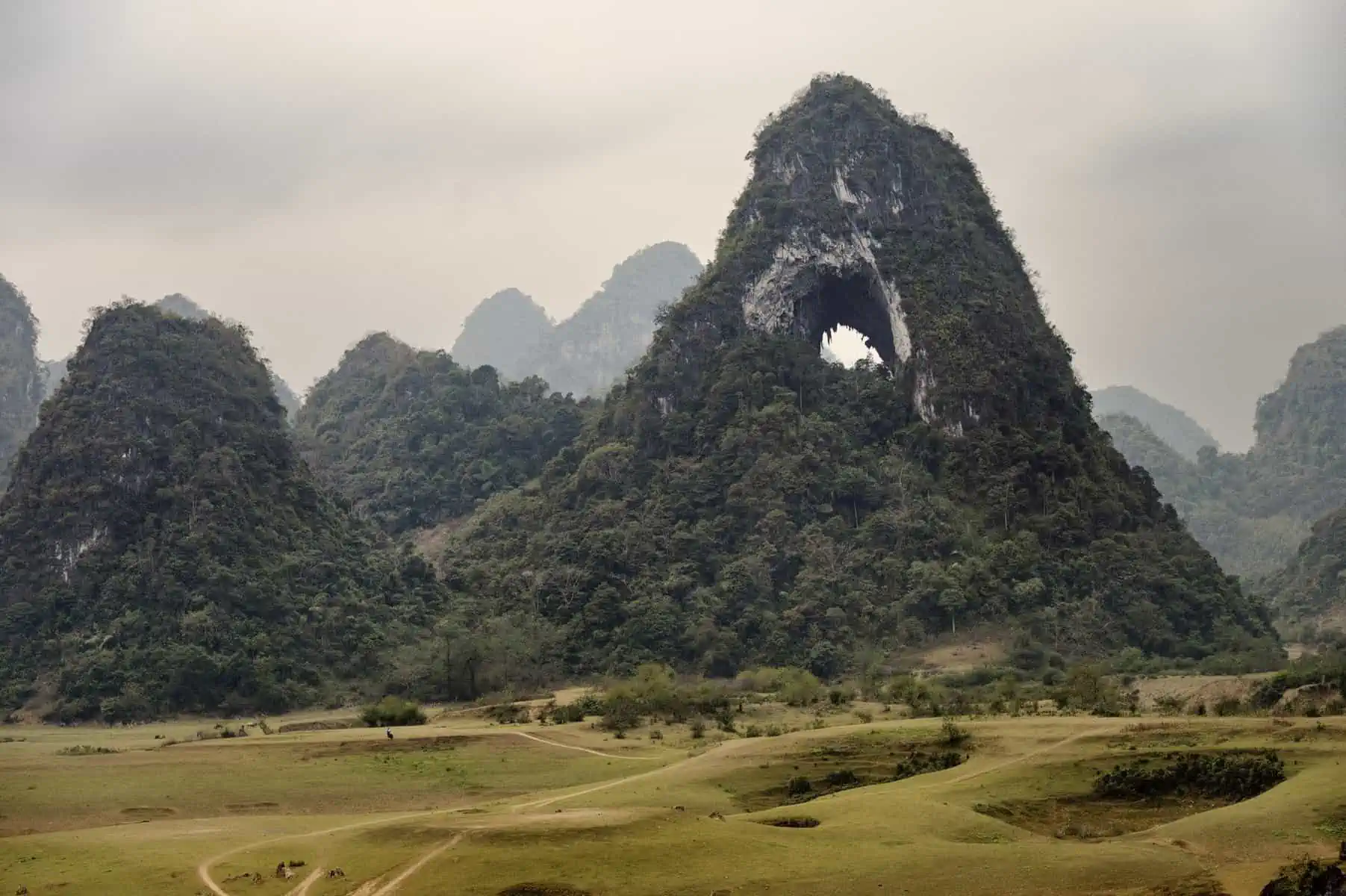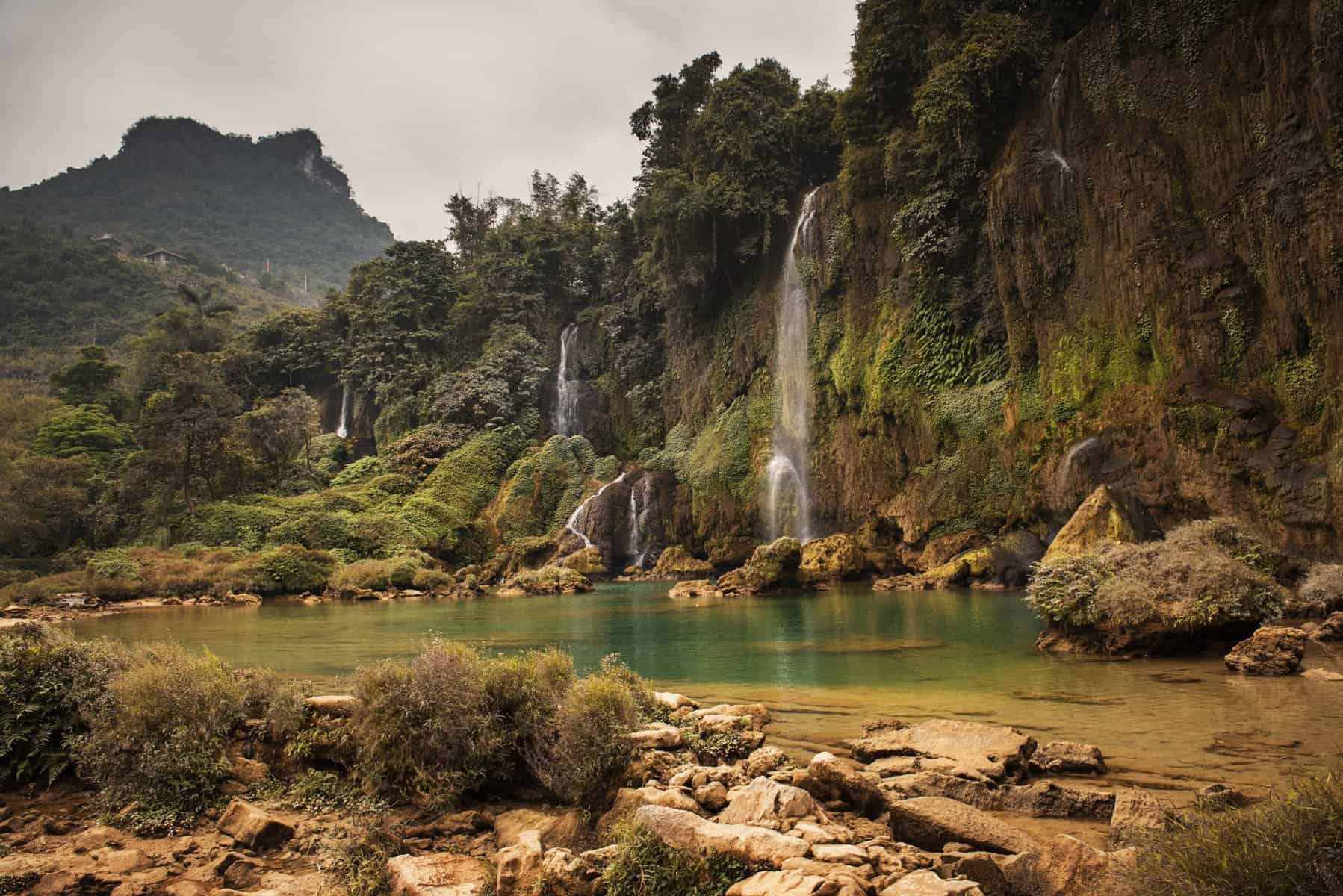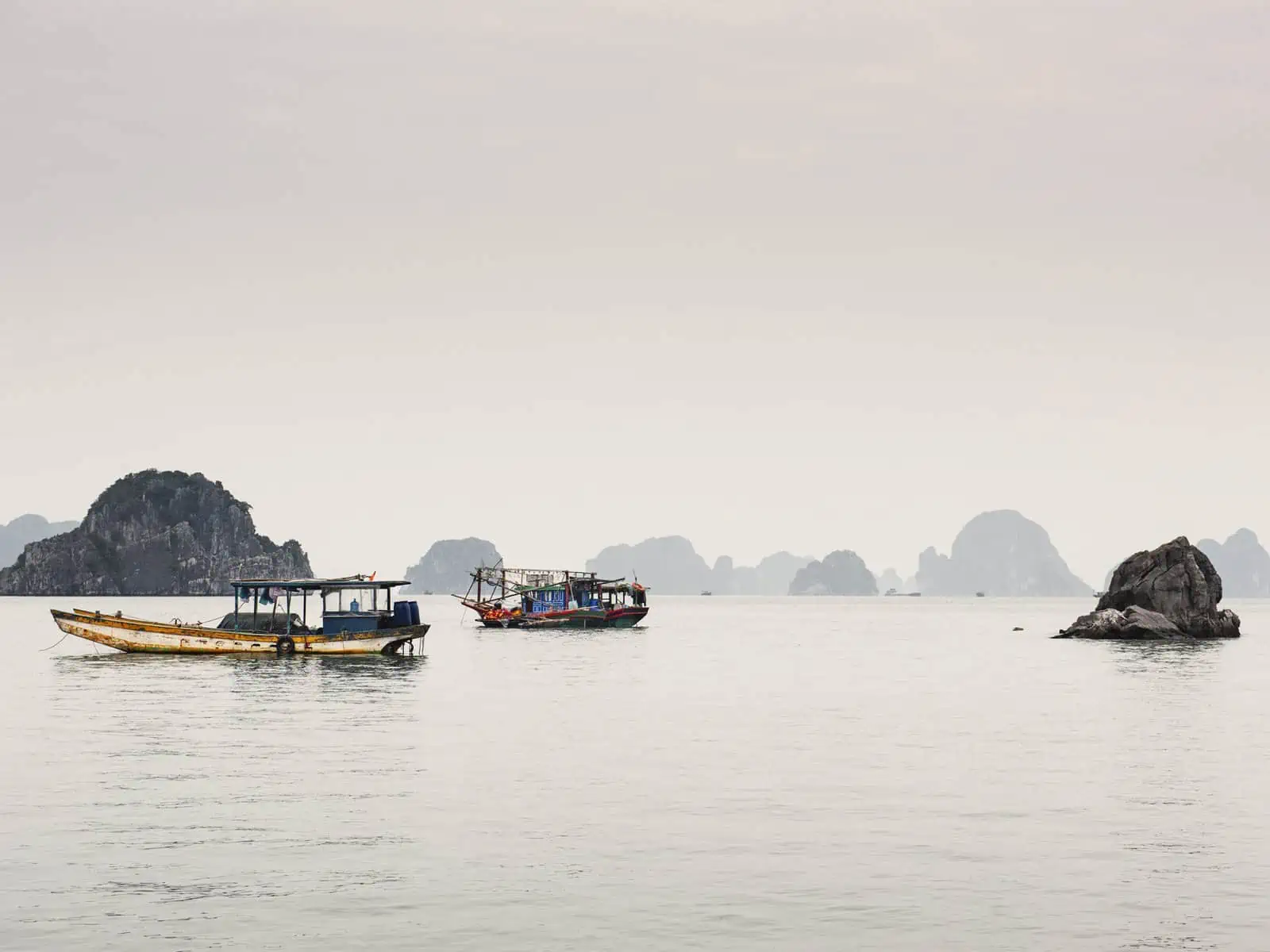Vietnam is an incredible country to visit all year round, however due to its size and shape, the weather in Vietnam couldn’t be any more different between the North, Center and South of Vietnam – from the Northern Highlands to the hot, tropical like South. When you decide to go will really depend on the type of trip you want to have and what you want to experience. To help you decide when would be the best time of year to go to Vietnam for you, we’ve outlined below the different seasons you can expect, if there’s an overall best time to go to capture the best of both worlds as well as the weather by month and what kind of activities are possible in each.
Table of contents:
- Is there an overall best time to visit Vietnam?
- Climate of Vietnam
- When is monsoon season in Vietnam?
- Best time to visit North Vietnam
- Best time to visit Central Vietnam
- Best time to visit South Vietnam
- Vietnam seasons
- Vietnam weather by month
Is there an overall best time to visit Vietnam?
Many say that the best time to visit Vietnam is between November and early April, with the weather in Vietnam and temperatures in both the North and the South being perfect for trekking and adventures. The temperatures are cooler at this time of year, but they’re also very doable if you’re used to alpine or slightly colder conditions, even in the mountains however you are likely to get cloudy days. In central Vietnam, such as Hue and Hoi An the rains have calmed and a second high season is beginning. Whether November to early April is the best time to visit Vietnam really depends on what it is you have in mind for your trip. If you are planning to try and explore as much of the country as possible and want the best weather possible to enjoy, then November to early April is possibly the best time to go to Vietnam. It’s also worth noting that depending on the calendar for the year, Tet, the Vietnamese New Year celebrations happen either at the end of January or into February. If you plan to travel around that time, be sure to book your flights and hotel as soon as possible as many places become booked up very quickly and raise prices. It’s also important to keep in mind that because it’s a country wide, family celebration, many restaurants will close around the week of the celebrations. We’d recommend doing some research to see when Tet falls if this is the time period you’re looking to travel in. However, travelling around Tet can be magical and the best time of year to visit Vietnam if you’re looking for a truly authentic experience!
Climate of Vietnam
Many people ask what is the climate of Vietnam, but it can’t be answered simply – due to its size, there isn’t one specific climate in Vietnam, with different areas of the country experiencing highly contrasting weather throughout the year. You can get cold days in the Northern mountains and hotter than hot days in the South, so it’s worth thoroughly considering when to visit Vietnam in terms of the kind of weather you want to experience. However, a trip to Vietnam is about much more than weather alone as there is so much to experience. But with that said, when rainy and monsoon season in Vietnam hits, it can really curtail a lot of adventure based plans, so always plan ahead! It’s entirely individual, and the worst time to visit Vietnam for you might be the best for someone else – that is what is truly wonderful about Vietnam.
When is Monsoon Season in Vietnam?
Monsoon season in Vietnam is between June, July and August in the North and South of Vietnam and between September, October and early November in central areas where rainy season in Vietnam typically eases by late mid to late November.
Related content: From the best things to do in Tunisia, to hikes in Sedona, Arizona, we’ve got you covered with our destination guides including itineraries, hikes and so much more.
Best time to visit North Vietnam (Hanoi, Halong Bay, Sapa, Ba Bae National Park)
The best time to visit North Vietnam and places such as Halong Bay, Bai Tu Long Bay (Halong Bay’s much quieter neighbor) and Ba Bae National Park is between the months of October to April. Whilst October may still be a little unsettled, and you may still experience some rain, you can expect to see incredible colors in the landscape. You’ll also see an abundance of produce being harvested, such as rice so it’s a great time to be in the countryside. November is also a great month to visit Halong bay and neighboring, much quieter Bai Tu Long Bay as you’re more likely to get clear skies. From December, the temperatures have cooled slightly, so from December on, you will more likely see cloudy days, though there is still the chance of sunshine. October until April is when adventures in the North really come alive – trekking and hiking in the North, the Highlands and around Ba Bae National Park is truly magical. Hanoi one of the best cities in Vietnam to visit at this time of year also, with humidity at a much lower level making exploring the city a much more pleasant experience.
Best time to visit Central Vietnam (Hoi An, Hue, beaches etc)
Between February and May and November to December are great times to visit Central Vietnam. Between February and May, the temperatures are perfect for visiting the coastal areas such as Hoi An and Hue. Whilst they can become extremely hot, they are also doable. November and December are also great times to visit, but we’d advise the latter half of November would be a safer bet, depending on when the storms and rainy season end. At these times of year, you can expect some cloudy days, but mostly sunny with the odd shower. The perfect time to visit central Vietnam is April, however this is a very popular time to visit so prices can creep up very quickly. If you’re planning to visit around this time, we’d recommend booking in as much advance as possible.
Best time to visit South Vietnam (Ho Chi Minh City, Mekong Delta)
The south experiences some of the best weather in Vietnam and the best time to visit the South of Vietnam is between December and March. This is when the weather is more settled, not as hot or as humid. This time of year also makes for a much more enjoyable experience checking out Ho Chi Minh City and everything on offer in the south such as Mekong Delta and the Can Gio Mangrove Biosphere Reserve is just 40km outside of Ho Chi Minh City.
Vietnam Seasons
High Season: July, August
- Best time for relaxing on the beach in central Vietnam
- Book well in advance, very popular
- The South is hot, and the north has monsoons
Shoulder Season: December, January, February, March, April
- Best overall time to visit Vietnam due to calmed climate which is suitable in most places
- Best time for checking out Hanoi and the North, such as Ba Bae National Park, Cao Bang, Highlands, Sapa
- Best time for adventures, trekking and backpacking
- Drier and colder, but warm and pleasant with less chance of rain
- One of the best seasons in Vietnam for visiting as much of the country as possible
- During Tet, the Vietnamese New Year festival, either in late January or early February depending on the calendar that year, a lot of things can be closed, and prices do get higher in hotels
- Weather is great in April, maybe even one of the best months to visit Vietnam
Low season: May, June and September, October and November
- The start of Monsoon season in the South and rainy season and storms in the North
- If visiting at this time, it’s better to focus on visiting cities and central Vietnam
- October and November are great for checking out the harvest and floating markets along the Mekong Delta
- Checking out Halong Bay in November is great because you’re likely to get clear skies
- Much quieter with less tourists
Vietnam Weather by Month
January in Vietnam
- Mostly dry season across the country
- Cold in the North
- Shops and Restaurants close for Tet
In January, it is generally dry in the North and South of Vietnam, but it’s important to remember that in the South it is still the end of rainy season, so you can expect some inclement weather. If you’re planning to visit the North and visit Halong Bay you can expect it to be colder, but it is none the less a really nice time to visit. It’s about 50/50 in January as to whether you’ll get a cloudy or sunny day for your visit, but it is spectacular at any time and even the cloudier days give the interesting rock sculptures you’ll see a beautiful feel. Hanoi is also a great place to visit in January as the slightly cooler, dryer temperatures make taking in the city and exploring a much nicer activity. You also have Dalat flower festival to look forward to in January too. If you’re looking for a quieter experience in the countryside and in nature, travelling to the far North of Vietnam to around Ba Bae National Park and Cao Bang is a great thing to do at this time of year. At higher elevations, you’re likely to experience colder temperatures, but January is a great time for adventures such as trekking, cycling and backpacking. It’s worth keeping in mind that depending on when Tet (the Vietnamese New Year celebration) falls, January can be a very busy time in the hotels all over Vietnam, with some of them even closing. So if you plan to travel as this time of year, you should look to book in as much advance as you can.
February in Vietnam
- Warmer temperatures in most areas of the country
- Great month for partaking in for adventure sports, hiking, canoeing etc.
- Beach resorts become busier due to increased temperatures
February is a great month for visiting Vietnam as the warmer more stable climate allows you to visit much more of Vietnam. If you’re planning to travel from North to South Vietnam, or vice versa, February is a great month to look at. It’s a great month for outdoors activities across the whole of Vietnam, particularly in the North and in the Highlands where you’ll find the temperatures mild but not too hot or too cold. The coast and central Vietnam are becoming busier at this time too. If Tet (the Vietnamese New Year festival) falls in February, it’s worth noting that hotels can get very busy, and because this is a popular month anyway, can be even busier than if Tet lands in January. It’s worth looking at when Tet falls on the particular year you’re looking to visit and planning accordingly. February can also be the best time to visit Vietnam and Cambodia on the same trip, due to the warmer temperatures and lack of rain.
March in Vietnam
- South Vietnam becomes much hotter
- Ideal time for hiking and exploring the North and one of the best times to visit Vietnam
March is a very popular time to visit Vietnam due to the warmer and much dryer weather you’re likely to experience. It’s also one of the best months to visit Halong Bay where you’re likely to find exceptionally sunny skies and little to no winds for the ultimate experience. Due to the sunnier skies and warmer temperatures, it’s also a really lovely time to take a trip to the North of Vietnam and visit places like Cao Bang, Angel Eye Mountain and Ban Gioc Waterfall. Depending on the particular year, you can even start to see the beginning of the spring flowers in the countryside and mountains towards the end of March if spring comes early – a truly beautiful sight to see. Nature truly feels like it is coming alive in the North of Vietnam in March, and the farmers you see will be in full action.
April in Vietnam
- Likely to see a profusion of Spring flowers
- Beach destinations are very popular
- Potentially the best month to visit Vietnam
April could very well be the best time to visit Vietnam, especially if you want to visit as many places as possible within the country. Whilst the South of Vietnam is becoming very hot around areas like Ho Chi Minh City, it is still doable. The North of Vietnam is wonderful in April and at this time of year you’re likely to see spring flowers cropping up everywhere in the countryside, which is well worth a visit! It’s also a fantastic time to visit Central Vietnam and the coast in areas like Hue and Hoi An, where temperatures are high, but can make for an amazing time, especially if you want to spend some time relaxing on the beach within your trip.
May in Vietnam
- Very hot temperatures in the South of Vietnam
- Showers to be expected in most locations
In May it is extremely hot in the South of Vietnam with temperatures reaching around 40c at times. Ho Chi Minh City is best avoided at this time due to the humidity and temperatures you’ll experience. If you’re planning to visit in May, its best to organize your trip around Hanoi or the central coast in areas such as Hoi An and Hue. You can still visit the mountains in the North of Vietnam in May, but there is likely to be rain as it’s approaching rainy season, though it can still be doable. However, because the weather is quite changeable in May, it’s possible to get a real deal on your trip with costs being much lower.
June in Vietnam
- Generally at the height of Vietnam’s monsoon season in the South
- Heavy rains and storms to be expected in the North – with adventure, hiking, trekking, and exploring off limits
In June the North of Vietnam experiences heavy rains and storms which can result in paths, roads and trails being flooded or very muddy, so unfortunately things like trekking and hiking are off limits. Whereas in the South of Vietnam, monsoon season has begun and so this isn’t the best time to visit and can lead to extensive flooding especially around the Mekong Delta. In June, you’ll need to focus your trip on central Vietnam in the areas of Hue or Hoi An. Central Vietnam is a much better option and you can often get a good deal as the coast is usually dry. The weather around central Vietnam is actually doable in June, with pleasant temperatures that make exploring much more possible. It can also be the best time to travel to Vietnam if you want to get a good deal on travel, due to the country generally being quieter at this time.
July in Vietnam
- Still at the height of rainy season in Vietnam: Generally wet in the North and South of Vietnam with monsoons continuing
- Good time to visit the central coast of Vietnam
July, in terms of weather in Vietnam is generally the same as June as it’s still at the height of Vietnam’s rainy season. Except you can expect monsoon and heavy rain conditions to potentially worsen in both the North and South of Vietnam. However, the coast and beaches of central Vietnam can be really beautiful to visit in July with temperatures reaching similar to what you’d expect in the Mediterranean at around 30c.
August in Vietnam
- Very rainy in the North of Vietnam and the Highlands
- Central coast is great to visit
- South of Vietnam is very hot with rain
You’ll have a great time in Vietnam if you’re planning to visit the center in August as temperatures are holding well from July with little rain and sunny skies. It’s a great time to visit places like Hoi An. In the North of Vietnam, August isn’t a good month to explore due to the heavy rains and storms which may well have caused significant impassable areas. The South of Vietnam is still very rainy at this time and extremely hot too. Due to flooding that is likely to have been experienced in the South of Vietnam, visiting the Mekong Delta wouldn’t really be possible in August, and visiting Ho Chi Minh City would be unpleasant because of the humidity.
September in Vietnam
- Storms start to come into central Vietnam
- The North of Vietnam is passable from late September
- Possible great time to see fall/autumn foliage if this comes early
Things start to really switch around in September with the weather in Vietnam when central Vietnam becomes stormy and very rainy. However, from mid September, depending on the year, the storms have eased off in the North and trekking, hiking and exploring the Northern mountains and countryside again becomes possible. At the end of September is also a great date to put into the calendar where the major harvest festival takes place in alignment with the full moon. The countryside is spectacular with goods being harvested and a flurry of activity to see. If Autumn/fall comes early that year, the colors to be seen in the countryside are truly beautiful, but this is more likely in October.
October in Vietnam
- Hiking and adventure in the North and South are easily enjoyed again
- Central Vietnam is wet, stormy and sometimes a lot cooler
- Rice harvest
In October, Central Vietnam is not a great place to visit as it is very stormy with heavy rains – if you visit in October, you won’t be able to take advantage of what central Vietnam is famous for (typically its paradise-like beaches and incredible cultural cities). However, October is a fantastic time for visiting the countryside of the North of Vietnam and into the mountains to see the rice harvest as well as the wonderful colors that pop up at this time of year in nature. In the South of Vietnam, there is also a flurry of activity, and it again becomes a great place to visit. If you’re visiting at this time, be sure to head to the Mekong Delta where the famous floating markets are packed full of incredible fresh produce and traditional, artisan offerings.
November in Vietnam
- Central Vietnam is still wet, stormy and colder
- Great time to visit the beaches of South Vietnam
- One of the best times for adventures in the North of Vietnam and one of the best months to visit Vietnam overall
- Clear skies in Halong Bay
November sees the start of the second high season that Vietnam experiences, but it really is at the beginning, so temperatures can be changeable. However, November is, aside from April, the best month to go to Vietnam to visit Halong Bay due to the clear skies. Much like earlier in the year, in April, you’re likely to have the best chance of experiencing Halong Bay in clear visibility. The temperatures in both the North and the South are also hot and dry at this time, with temperatures in the mountains pleasant because of the low humidity. However, it’s best to avoid central Vietnam at this time due to continued stormy conditions.
December in Vietnam
- Temperatures are hot across the country, but cooling to more manageable temperatures
- Christmas makes Vietnam busy, with it being a popular destination for Christmas holidays so prices can go up
- Rain calms down in Central Vietnam
Much like January, December is a great time to visit Vietnam as you have the opportunity to visit many locations in Vietnam from North to South and experience the best of all. There is still a good chance of rain in central Vietnam in December, however through the month, this becomes less and less as January gets closer. Both Northern and Southern Vietnam have great opportunities for adventure trips and treks at this time as the mountains are dry and warm but becoming cooler at night (and sometimes cooler in the day). However, because Christmas falls in December, it is advisable to book early to secure at a reasonable price as it does become busier and more expensive at this time.
Conclusion
As you can see, there really is no best time to visit Vietnam as this depends completely on what you want from your trip. Whilst November – April are some of the best times to visit Vietnam if you’re looking to explore as much of the country as you can. It’s also possible to find great deals at some of the quieter times of year if you’re on a tight budget and want to devote time to one particular area only. We hope this guide makes it easier for you to find the best time to travel to Vietnam for your plans and what you have in mind. For more Vietnam travel guides and information such as the key cities in Vietnam to visit and other resources, check out our Vietnam travel hub.
Discover more about Vietnam:




